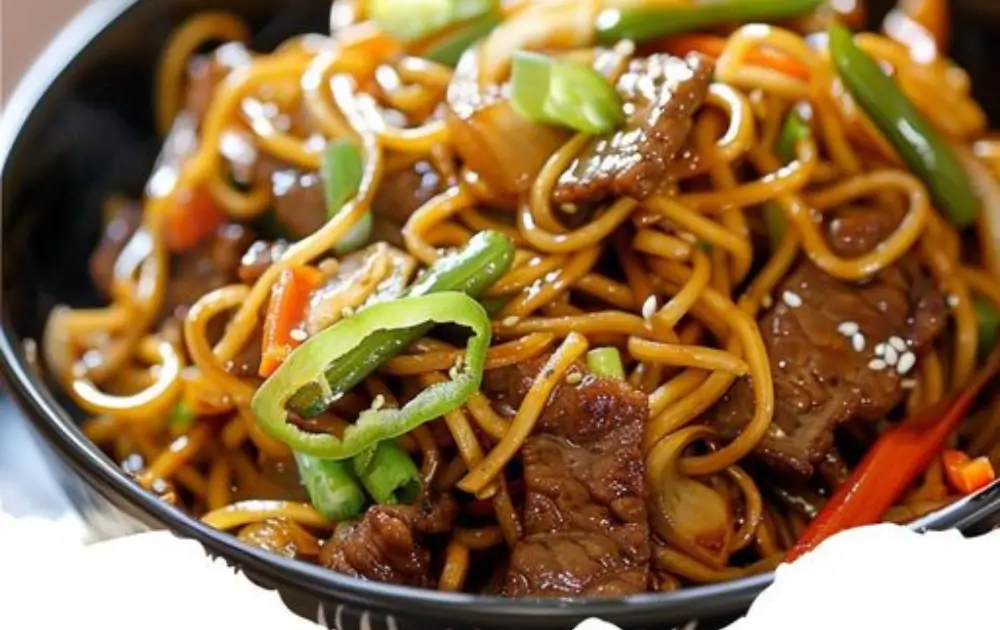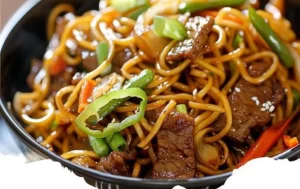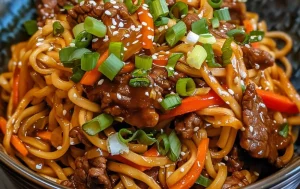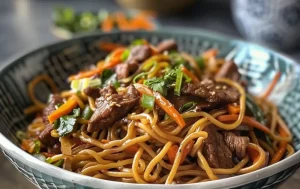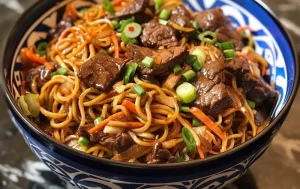Beef Chow Mein is a classic dish in Chinese cuisine that has won the hearts of many around the globe. This stir-fried noodle dish, featuring tender slices of beef, crisp vegetables, and savory sauce, is a staple in both Chinese restaurants and home kitchens. It perfectly combines the rich flavors of the beef with the freshness of the vegetables, all brought together with a deliciously seasoned sauce over a bed of noodles. Whether you’re a seasoned chef or a cooking novice, Beef Chow Mein is a versatile dish that promises satisfaction in every bite.
Selecting Quality Ingredients
For a truly flavorful Beef Chow Mein, the selection of quality ingredients is key. Start with a good cut of beef, such as flank steak, which is lean yet tender and slices easily. Freshness in your vegetables will also make a significant difference—think crisp bell peppers, beansprouts, and green onions for a variety of textures and flavors. The noodles, whether fresh or dried, should be of good quality, with egg noodles being the most traditional choice for their chewy texture and ability to soak up the sauce.
Preparing the Beef and Vegetables
Before diving into cooking, ensure your beef is thinly sliced against the grain to maximize tenderness. Marinating the beef slices in a mixture of soy sauce, sesame oil, and a touch of cornstarch can add depth of flavor and give the beef a velvety texture. For the vegetables, keep the pieces uniform in size to ensure even cooking. Quick blanching of denser vegetables like broccoli or carrots can keep them vibrant and crisp in the final dish.
Mastering the Stir-Fry Technique
The secret to a successful Beef Chow Mein lies in the stir-fry technique. A high heat and a well-seasoned wok or large frying pan are essential to achieve the characteristic ‘wok hei’—the slightly smoky flavor of well-executed stir-fry. Ensure the wok is hot before adding oil, then cook the beef until just browned before setting it aside. Stir-fry the vegetables next, keeping them moving in the pan to prevent burning, then add the noodles and beef back into the wok, tossing everything together with the sauce until well combined and heated through.
Crafting the Perfect Sauce
The sauce in Beef Chow Mein ties all the components together and is crucial for achieving the right balance of flavors. A combination of soy sauce, oyster sauce, a splash of Chinese rice wine, and a hint of sugar can create a rich and savory sauce that complements the beef and vegetables. For those who enjoy a bit of heat, a dollop of chili paste or a sprinkle of red pepper flakes can add a welcome spice. Adjust the seasoning to taste, ensuring a harmonious blend of sweet, salty, and umami elements.
Serving and Enjoying
Beef Chow Mein is best served fresh from the oven, piping hot. Garnish with a sprinkle of sesame seeds and fresh chopped green onions for an extra layer of flavor and a pop of color. Pair with a side of chili oil or soy sauce for those who prefer to customize the taste further. This dish is not only a satisfying meal on its own but also a fantastic addition to a larger spread of Chinese-inspired dishes, making it perfect for family dinners or gatherings with friends.
incorporating Dietary Variations
Beef Chow Mein is adaptable to various dietary preferences and restrictions. For a gluten-free version, opt for tamari or a certified gluten-free soy sauce and ensure your noodles are free from gluten-containing ingredients. Vegetarians can substitute beef with tofu or a medley of mushrooms, such as shiitake or portobello, to maintain the dish’s hearty texture while aligning with plant-based eating habits. Adding a splash of vegetable stock can enhance the flavors when adapting the recipe for vegetarians or vegans.
Enhancing with Additional Ingredients
To elevate Beef Chow Mein, consider incorporating additional ingredients that complement the base flavors. A handful of cashews or peanuts can add a crunchy texture and nutty taste. For a burst of color and extra nutrients, throw in some spinach or kale during the last minutes of stir-frying to wilt slightly. Pineapple chunks can introduce a sweet and tangy element, creating a delightful contrast with the savory beef.
Achieving the Perfect Noodle Texture
The texture of the noodles is crucial in Beef Chow Mein. To avoid overcooked or clumpy noodles, cook them slightly less than the package instructions suggest since they will continue cooking when stir-fried with the other ingredients. After boiling, rinse the noodles under cold water to stop the cooking process and toss them with a bit of oil to prevent sticking. This ensures the noodles remain distinct and absorb the sauce effectively during the final stir-fry.
Customizing the Heat Level
While Beef Chow Mein traditionally has a balanced flavor profile, customizing the heat level allows you to tailor the dish to individual palates. Incorporate chili oil, Sriracha, or sliced fresh chilies to the sauce for those who appreciate spicier fare. Alternatively, serving the chili sauce on the side lets everyone adjust the spice to their liking, making the dish versatile for a range of taste preferences.
Celebrating Cultural Authenticity
Embracing the cultural origins of Beef Chow Mein enriches the cooking and dining experience. Understanding the dish’s roots in Chinese cuisine and the tradition of stir-frying can inspire a deeper appreciation for the ingredients and techniques used. Sharing this knowledge with family and friends as you enjoy the meal together fosters a connection to the rich culinary heritage behind Beef Chow Mein, turning a simple dinner into a cultural exploration.
Leveraging Leftovers for Creative Meals
Beef Chow Mein’s versatility doesn’t end with the initial serving; leftovers can be transformed into new and exciting meals. Consider using them as a filling for wraps or omelets the next day, providing a flavorful twist on breakfast or lunch. Alternatively, add a beaten egg and some extra vegetables to the leftover chow mein, pan-frying to create a savory pancake or frittata. These creative uses not only minimize food waste but also keep your meals interesting and varied.
Optimizing Cooking Order for Maximum Flavor
To ensure each component of Beef Chow Mein shines, paying attention to the cooking order is crucial. Begin by stir-frying the beef until it’s just cooked through to maintain its tenderness, then remove it from the pan to prevent overcooking. Vegetables should be added according to their cooking times; start with the harder, denser ones like carrots and bell peppers, adding quicker-cooking items like beansprouts and green onions towards the end. This method ensures that all ingredients reach their ideal texture, contributing to the overall harmony of the dish.
Incorporating Seasonal Vegetables for Freshness
Embrace the seasons by incorporating seasonal vegetables into your Beef Chow Mein. Spring offers tender greens and asparagus, summer brings bell peppers and zucchini, autumn introduces squash and mushrooms, and winter provides hearty options like kale and cabbage. Utilizing seasonal produce not only enhances the freshness and flavor of your chow mein but also supports local farmers and reduces the environmental impact associated with transporting out-of-season produce.
Mastering the Sauce to Noodle Ratio
The secret to a perfectly moist yet not soggy Beef Chow Mein lies in mastering the sauce-to-noodle ratio. The sauce should be just enough to coat the noodles and vegetables, lending flavor without pooling at the bottom of the dish. If you prefer a drier chow mein, reduce the sauce volume slightly; for a saucier dish, increase the liquid components proportionally. Adjusting the sauce according to your preference allows you to achieve the ideal balance for your taste buds.
Sharing the Joy of Cooking with Others
Beef Chow Mein is more than a dish; it’s an opportunity to connect with others through the joy of cooking and sharing a meal. Invite friends or family members to participate in the cooking process, from chopping vegetables to stirring the wok. This collaborative effort not only makes the cooking experience more enjoyable but also turns the meal into a shared achievement. Celebrating the finished dish together reinforces the social aspect of dining, making Beef Chow Mein a meal that nourishes both the body and the spirit.
FAQs about Beef Chow Mein
Q1: Can I use pre-cooked noodles for Beef Chow Mein? A1: Yes, you can use pre-cooked noodles to save time. Just ensure they’re properly reheated and loosened before adding them to the stir-fry to prevent clumping.
Q2: How can I make my beef chow mein sauce thicker? A2: To thicken the sauce, mix a small amount of cornstarch with water to create a slurry and add it to the sauce as it cooks, stirring until it reaches your desired consistency.
Q3: What’s the best way to reheat leftovers? A3: For the best results, reheat beef chow mein in a pan over medium heat, adding a little water or broth to help loosen the noodles and vegetables. Avoid using a microwave, as it can make the noodles mushy.
Q4: Can I substitute beef with another protein? A4: Absolutely! Chicken, pork, shrimp, or tofu can be used as alternatives to beef, allowing you to customize the dish according to your dietary preferences or what you have on hand.
Q5: How do I prevent my beef from becoming tough and chewy? A5: To keep the beef tender, slice it thinly against the grain and do not overcook it. Quick searing on high heat ensures it remains juicy and tender.
Conclusion
Beef Chow Mein is a beloved classic that marries the rich flavors of beef with the crunch of fresh vegetables and the comforting texture of noodles, all tied together with a savory sauce. Mastering this dish not only adds a versatile recipe to your culinary repertoire but also offers a delightful way to explore the flavors of Chinese cuisine. Whether you’re cooking for one, a family dinner, or a gathering of friends, Beef Chow Mein proves to be a satisfying meal that brings joy and warmth to any table. With the tips and variations provided, you can customize the dish to suit any taste or occasion, making it a staple in your collection of go-to recipes.
Print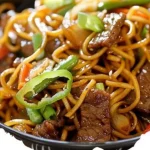
Beef Chow Mein
- Author: recipstep
- Total Time: 40 minutes
- Yield: 4 servings 1x
Description
Beef Chow Mein is a savory, stir-fried noodle dish that combines tender slices of beef with crisp vegetables and flavorful noodles in a rich sauce. A staple of Chinese cuisine, it’s a versatile and quick meal perfect for busy weeknights or whenever you’re craving a satisfying dish with a balance of protein, veggies, and carbs.
Ingredients
2 portions of noodles (300 g / 10.6 oz, fresh egg noodles)
1.5 tbsp soy sauce
3 tbsp oyster sauce
1.5 tsp dark soy sauce
3 tbsp peanut oil
300 g (10.6 oz) beef (chuck, flank, ribeye, sirloin steak)
1/4 tsp salt
1/8 tsp baking soda
2 tbsp chicken or vegetable broth
1/2 tbsp soy sauce
1/2 tbsp cornstarch
Black pepper to taste
1 medium-size onion, thinly sliced
3 scallions, cut into 2-inch pieces
Instructions
Slice and Marinate the Beef:
Slice 300g of beef into 1/8-inch thick pieces.
Marinate with 1/4 tsp salt, 1/8 tsp baking soda, 2 tbsp chicken or vegetable broth, 1/2 tbsp soy sauce, 1/2 tbsp cornstarch, and black pepper. Let it sit for 20 minutes.
Cook the Noodles:
Boil 2 portions of fresh egg noodles for 2-3 minutes or per package instructions.
Drain and set aside.
Prepare the Wok:
Heat a wok on maximum heat until smoking hot.
Add generous oil to create a non-stick surface.
Wait for the oil to smoke before adding marinated beef. Stir and cook.
Cook the Beef and Onions:
When beef is halfway cooked, add sliced onions. Stir for 15 seconds.
Add Noodles and Scallions:
Remove noodles from water, add scallions to the wok along with noodles.
Turn off the heat.
Season the Chow Mein:
Add 1.5 tbsp soy sauce, 3 tbsp oyster sauce, and 1.5 tsp dark soy sauce.
Mix until well combined.
Adjust Flavor and Serve:
Taste and adjust seasoning.
Optional: Add toasted sesame oil for extra flavor.
Enjoy your delicious Beef Chow Mein!
Pro Tips:
Control wok heat: Heat wok until smoking hot before adding oil.
Be generous with oil to prevent noodles from sticking.
Turn off the heat before adding noodles for authentic Lo Mein texture.
Use high-quality oyster sauce for a key flavor boost.
Adjust seasoning based on sodium levels in soy and oyster sauce.
Notes
- For a spicier dish, add a drizzle of chili oil or a sprinkle of red pepper flakes.
- Substitute or add vegetables according to preference or seasonality.
- Prep Time: 20 minutes
- Cook Time: 20 minutes
- Category: Main Dish
- Method: Stir-Frying
- Cuisine: Chinese
Nutrition
- Calories: 450
- Sugar: 5g
- Sodium: 900mg
- Fat: 18g
- Saturated Fat: 3g
- Carbohydrates: 45g
- Fiber: 3g
- Protein: 25g
- Cholesterol: 60mg

